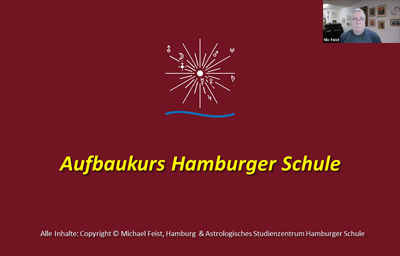Start November 2025
The course is held online, each Saturday from 3 pm (1-2 hours each). The cost contribution is 291,55€.
Conducted by Michael Feist
Information & Contact:
(This is a translation from German. Please note that this offer is aimed at people who speak German.)
Prior participation of the basic astrology course is a prerequisite for the advanced course. Ideally, the topics of the basic course should have been consolidated with the glossary of the basic astrology course - and you should have some experience of using the techniques of the Hamburg School.
Course content advanced course
Questions, ethics and self-control
At the start of the course, we will discuss any unanswered questions and the tools available to us. If you have any specific questions, you can send them to us before the start of the course or call us to arrange an appointment. We will discuss the limits and possibilities of astrology, as well as points that require an ethical approach to astrology.
Basic structures
What does the first contact with a horoscope look like? The possibilities of the Hamburg School (Uranian Astrology) are complex, but on closer inspection the application is simple. Unfortunately, the most important and simplest step is often skipped: the superficial analysis of the basic structure. This analysis is important because basic structures provide a rough overview. These structures will also prove important in temporal triggers and events.
Basic structures 1
The superficial analysis of the basic structure is shown. Firstly, the data situation of the horoscope is critically analysed. What should you pay attention to? What helps with the analysis? What mistakes can be made? This teaching point is very important. Incomprehensibly, this point is neglected in other courses. On the one hand, the basic data says a lot about the horoscope, on the other hand, the most common mistakes are made when entering the basic data into the computer. We then discuss high-level basic structures and basic structures in symmetrical division, as well as the orb. You will realise that the superficial analysis is an important step for the subsequent detailed work.
Basic structures 2
A methodically structured basic analysis of the personal horoscope with the personal points is shown. In addition the working with the 360° and 90° discs, computer lists are explained and houses are used to further differentiate the half-sum (mid points) analysis. This methodical approach is a common thread that will guide the astrological work in a structured way.
Basic structures 3
The basis of astrology are angles in the horoscope, which are calculated as differences. Differences are shown in the basic structure directly in 360° - or indirectly in the symmetrical divisions. They are also important in the application of the two-disc technique, i.e. in the temporal triggering of the solar arc, as well as in a special method of comparing partnerships. Basic Structures Part 3 introduces these topics.
Auxiliary horoscopes
In order to derive temporal changes from the horoscope, numerous auxiliary horoscopes are available, which are used in combination with the radix. As a rule, the work is limited to certain auxiliary horoscopes that are selected to suit the respective examination. In this part of the advanced course, the topic of auxiliary horoscopes is explained in three categories: directions (progressions), as well as natural bound and unbound horoscopes of the current factors.
The secondary progression and the solar arc direction are explained in more detail and the calculation of the solar arc with the ephemeris is shown (see also Glossary Basic Astrology Course, page A/73). In addition, the progressive daily meridian according to Alfred Witte (MCw or pTM) is discussed. The two-disc technique with the solar arc is repeated and the different ways of triggering the solar arc (1/2, 1/1 and 2/1) are explained. It also warns against mistakes that can occur even after many years of experience.
Mundane astrology
Individual astrology is usually at the centre of investigations, but the oldest application of astrology is probably mundane astrology, which is mainly based on the cyclical movements of the sun, moon and planets.
In the Uranian Astrology, the coming year has been analysed using the mundane annual horoscope since the early beginnings of the method. But when is the time that represents the year? We look at the differences between traditional astrology and the Uranian Astrology and look back to the origins in antiquity. We then analyse an annual horoscope.
Synchronisation of the birth chart
Individual astrology relies on the registration of an exact time and place of birth, but this information is not always reliably available. Depending on the data available, the horoscope should be checked for consistency and adjusted if necessary. If there are discrepancies, the horoscope is synchronised to match the events. This usually results in a "new" birth time. This process is known as "rectifying the birth time". Depending on the quality of the data and information on the horoscope, different methods are suitable for synchronisation. We look at synchronisation with the solar arc and sensitive points. We also discuss the uncertainties of the time of birth and look at the conditions of the official data basis.
Sensitive points and transits
The "sensitive points" have their origin in the so-called "Arabic parts" or "lots". In Uranian Astrology, the sensitive points form the basic framework from which all horoscope structures can be derived. The basic idea of this application was already laid down in Claudius Ptolemy's "Tetrabiblos" around 2000 years ago. We look at this historical basis using the example of the "Wheel of Fortune" and the derivations of the principle in the Hamburg School aka Uranian Astrology.
On the basis of the sensitive points, we discuss the topic of "transits" from the perspective of the Hamburg School. We prove Alfred Witte's assertion that transits via radix factors only inadequately outline an event, but that the sensitive points in the radix addressed by transits offer far more reliable indications of the event.
Conducted by Michael Feist
Information & Contact:


